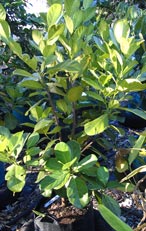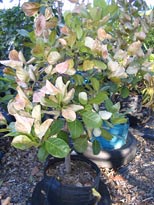
July 2004
The Daley News
What's New in the Nursery
 .Welcome to winter, this is always a refreshing time up here on the North coast of NSW when we remember how it feels to be cold, even if this is only for a few hours in the early morning. It is also a time to busily prepare for spring; we are pruning, fertilizing and protecting our precious plants from frosts. Frost can be a devastating thing in the garden for those who are not prepared, but with a little preparation those plants that are sensitive can be helped through the winter period. Ideally we would only grow trees suited to our climate but being human we are always trying to grow things outside their ideal envirement.
.Welcome to winter, this is always a refreshing time up here on the North coast of NSW when we remember how it feels to be cold, even if this is only for a few hours in the early morning. It is also a time to busily prepare for spring; we are pruning, fertilizing and protecting our precious plants from frosts. Frost can be a devastating thing in the garden for those who are not prepared, but with a little preparation those plants that are sensitive can be helped through the winter period. Ideally we would only grow trees suited to our climate but being human we are always trying to grow things outside their ideal envirement.
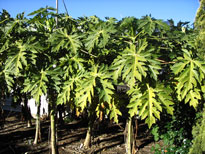 The stem of the plant is the most important part to protect from frost; this is where it gets the coldest and where any damage is the most devastating for the health of the plant. Protection can be as simple as wrapping the stem of the plant in newspaper, or as complicated as building a frost proof protection around the plant. Here at Daleys we have several systems in place to protect our plants from frost. Our main system is an automated sprinkler system which is connected to a thermostat and automatically comes on when the air temperatures reach –1 degrees C, this forms a layer of ice over the plant which ironically protects the plants from frost damage. In the change between water and ice there is a transfer of energy that heats the surface of the plant, protecting the cells in the plant from freezing. This is a very successful method for us here where we have sprinklers set up over most of our plants but probably not so easy for the home gardener. The Paw Paws above would be looking like bare branches from some of the heavy frosts we have been having this winter if not for our overheading sprinkler protection.
The stem of the plant is the most important part to protect from frost; this is where it gets the coldest and where any damage is the most devastating for the health of the plant. Protection can be as simple as wrapping the stem of the plant in newspaper, or as complicated as building a frost proof protection around the plant. Here at Daleys we have several systems in place to protect our plants from frost. Our main system is an automated sprinkler system which is connected to a thermostat and automatically comes on when the air temperatures reach –1 degrees C, this forms a layer of ice over the plant which ironically protects the plants from frost damage. In the change between water and ice there is a transfer of energy that heats the surface of the plant, protecting the cells in the plant from freezing. This is a very successful method for us here where we have sprinklers set up over most of our plants but probably not so easy for the home gardener. The Paw Paws above would be looking like bare branches from some of the heavy frosts we have been having this winter if not for our overheading sprinkler protection.
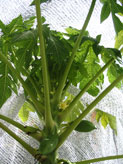
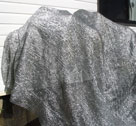 Our other method is to build a protective cover out of aluminate, an aluminum fabric similar in structure to shade cloth. This keeps radiant heat in at night reflecting the heat from the earth back to the plant. It is very successful and simple for the home gardener; it can be left over the plants, as it is transparent and breathable. Many other things can be used as a cover, old sheets and blankets are great but must be removed in the day and replaced at night, beware using plastic as the frost will burn through wherever it touches the plant.
Our other method is to build a protective cover out of aluminate, an aluminum fabric similar in structure to shade cloth. This keeps radiant heat in at night reflecting the heat from the earth back to the plant. It is very successful and simple for the home gardener; it can be left over the plants, as it is transparent and breathable. Many other things can be used as a cover, old sheets and blankets are great but must be removed in the day and replaced at night, beware using plastic as the frost will burn through wherever it touches the plant.
For large established plants that are sensitive to frost but too large to cover for example avocados and paw paws as long as the frost are not too severe they will recover in the spring with a burst of new growth. However do not be tempted to cut out the unsightly damage that the frost has caused until the frost period is completely over. Those brown and burnt leaves are creating a protective layer for the leaves under them; in fact they are forming a natural protection for the plant. All young, sensitive plants should be protected from frost if you do not want to loose them. This includes young citrus plants where stem protection is most vital.
|
Young Jakfruit protected by overhead sprinker. After ice melted off leaves there is no sign of damage |
Jakfruit showing frost damage with no overhead sprinkler protection |
Another tip to decreasing the damage from frost is to remove the mulch from around sensitive plants. This has the effect of heating the ground temperature, it is warmed in the day by the sun and that warmth is released at night. Mulch prevents this from happening. It will be important to replace this mulch in the spring when the risk of frost has passed and the ground temperatures have risen.
Another of our winter tasks is pruning. As this is the gardens most dormant period it 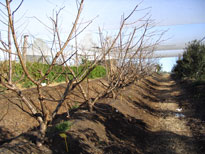 is a wonderful time to be planting and pruning deciduous trees. The aim of pruning is; to control the size and habit of a tree; to remove any dead, damaged or diseased material; to stimulate new growth, encouraging flowers and fruit; and of course to establish the desired form of the tree. The best thing about pruning is that if you make a mistake and get it all wrong it is nothing to worry about as it will all grow back and you will get another go at it next year, so have no fear. Sharpen those pruning tools and have a go. For those of you who are just beginning to establish an orchard I would highly recommend the little book Pruning for Fruit by Bruce Morphett, published by the Adelaide Botanic Gardens. This is available from us with all mail orders.
is a wonderful time to be planting and pruning deciduous trees. The aim of pruning is; to control the size and habit of a tree; to remove any dead, damaged or diseased material; to stimulate new growth, encouraging flowers and fruit; and of course to establish the desired form of the tree. The best thing about pruning is that if you make a mistake and get it all wrong it is nothing to worry about as it will all grow back and you will get another go at it next year, so have no fear. Sharpen those pruning tools and have a go. For those of you who are just beginning to establish an orchard I would highly recommend the little book Pruning for Fruit by Bruce Morphett, published by the Adelaide Botanic Gardens. This is available from us with all mail orders.
.....Our Favourites for July.....
Carambola, The Star Fruit
 Carambola’s are one of my favourite fruits and this is not only because they are delicious, it is their texture, shape and visual appeal that I like. The skin of the carombola is glossy, smooth and edible. The fruits are large and amazing with five wavy ribs that transverse the length of the fruit, the ribs give the fruit it’s star shape when cut in cross section. They are best eaten fresh when the colour changes from green through to a golden hue, they will drop from the tree when fully ripe and are easily damaged so they are best picked just before they fall. As with all fruits, tree ripen carambolas are superior in flavour, use ripe fruit within a few days, although they can be stored in the
Carambola’s are one of my favourite fruits and this is not only because they are delicious, it is their texture, shape and visual appeal that I like. The skin of the carombola is glossy, smooth and edible. The fruits are large and amazing with five wavy ribs that transverse the length of the fruit, the ribs give the fruit it’s star shape when cut in cross section. They are best eaten fresh when the colour changes from green through to a golden hue, they will drop from the tree when fully ripe and are easily damaged so they are best picked just before they fall. As with all fruits, tree ripen carambolas are superior in flavour, use ripe fruit within a few days, although they can be stored in the 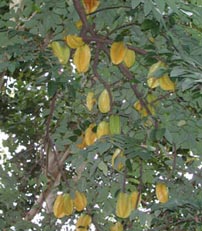 refrigerator, frozen, pickled, preserved and dried their delicate flavour is not enhanced by any of these processes.
refrigerator, frozen, pickled, preserved and dried their delicate flavour is not enhanced by any of these processes.
The carambola tree Averrhoa carombola is highly ornamental with its bushy rounded crown of small leaflets that can be semi deciduous in colder areas. It can withstand small frosts that make it suited to sub tropical climates even though it originates from Sri Lanka and the Moluccas in the tropics. The tree is slow growing to about 5m in the subtropics up to about 9 in the warmer areas. It is beautiful in flower when it is covered in small pink to lilac flowers and looks amazing in full fruit.
It is an easy tree to grow as it is not fussy about soil types and has no major pests or diseases. It will crop twice a year once at the beginning of winter and again at the beginning of summer. When it is young it  can be susceptible to frost damage so it is recommended to protect young plants it also does not like hot dry winds or floods. Carambolas make great container plants and will begin cropping within 2years. Pruning several times a year will induce out of season fruiting and also keep the tree looking very ornamental.
can be susceptible to frost damage so it is recommended to protect young plants it also does not like hot dry winds or floods. Carambolas make great container plants and will begin cropping within 2years. Pruning several times a year will induce out of season fruiting and also keep the tree looking very ornamental.
Sliced carambolas make a beautiful garnish for any type of salad, sweet or savory, they look amazing with seafood and avocados and are delicious stewed with apples and cloves.
Kakudu Plum – Terminalia ferdinandiana
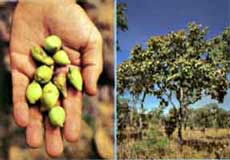 The Kakudu plum also has the less appealing common name of the Billy Goat Plum is native to and widely distributed throughout tropical Australia, it has been used by Indigenous Australians for food, medicine and timber. The Kakudu plum is a small to medium sized deciduous spreading tree growing 5-10 m, its large leaves are light green and spirally arranged towards the ends of its branches and flakey pale bark. The tree drops its leaves in the winter for a short period from July to August. The small flowers are fragrant and borne towards the ends of the branches from September to December. The almond sized fruits ripen from March onwards.
The Kakudu plum also has the less appealing common name of the Billy Goat Plum is native to and widely distributed throughout tropical Australia, it has been used by Indigenous Australians for food, medicine and timber. The Kakudu plum is a small to medium sized deciduous spreading tree growing 5-10 m, its large leaves are light green and spirally arranged towards the ends of its branches and flakey pale bark. The tree drops its leaves in the winter for a short period from July to August. The small flowers are fragrant and borne towards the ends of the branches from September to December. The almond sized fruits ripen from March onwards.
The fruits are small, pale green to yellow with a pleasant flavour, they are an excellent source of vitamin c and are fantastic to use in jams and preserves. The large seeds can adhere themselves firmly to the flesh of the fruit which is their only downfall when preparing them. They are beginning to become popular outside the Indigenous community as interest in our native Australian bush foods grows. I picked up a bottle of Kakudu plum and chilli sauce from my local supermarket the other day that is delicious, sweet and spicy and made by Indigenous people, a true bush food product.





